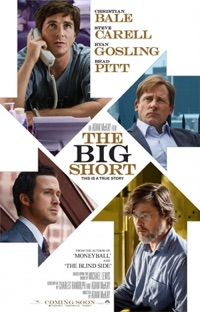
I managed to catch the movie The Big Short (trailer) before it left the theaters. Having read the book with great interest back in 2011, I wondered how it would remade for the big screen. Isn’t it hard to believe that the events described started roughly an entire decade ago? There are plenty of reviews at all the big media sites, but here are my notes:
- The original book The Big Short by Michael Lewis was classified as non-fiction.* The movie, however, is only “based on a true story”. As such, many of the individual names were changed. Steve Eisman (real person) became Mark Baum (movie character). Ben Hockett became Ben Rickert. Charles Ledley & James Mai became Charlie Geller & Jamie Shipley. Cornwall Capital became Brownfield Capital. For some reason, the names of Dr. Michael Burry and his firm Scion Capital went unchanged.
- The director, Adam McKay, is probably best known for his comedies with Will Ferrell in Anchorman and Talladega Nights. Oh, and the classic short The Landlord (censored version). I suppose The Big Short could be called a dark comedy.
- In retrospect, it might seem like betting against the housing market was an easy and obvious bet. While the movie might dramatize things, it did take courage and conviction. They had to put up millions of dollars to place the bet, and then more millions to keep the derivative bets running. Most other investors thought they were stupid, and tried to get them to reverse the bets. The banks also tried to make them sell their positions before they could realize profits. They were risking their own money, their family and friends’ money, and their entire careers.
- The movie does a good job showing you how the bubble persisted for so long because everyone was incentivized to keep it going. Wall Street workers made money by packaging and selling the bonds. The pension funds and large institutions got to buy “safe” high-interest bonds. The money managers got to collect their fees. The mortgage brokers and real estate agents collected commissions. Homeowners saw their equity grow. Everyone was happy.
- In contrast, the people who did the contrarian bet were all on the margins, outsiders, even a little weird. Hedge funds run by a guy who avoided human contact and wore cargo shorts and a free t-shirt everyday. (Christian Bale actually asked the real Michael Burry to take off his cloths and give them to him.) Another one based out of their parent’s garage.
- The revolving door between the regulators and the industry that they regulate remains open. People go from big paychecks on Wall Street, to smaller paychecks at the SEC and other government roles, and then go back to big paychecks on Wall Street. People usually don’t like to burn bridges with future employers. See this Michael Lewis interview.
- * As the book was non-fiction, CDO manager Wing Chau actually sued Michael Lewis for libel. Chau’s defamation lawsuit was dismissed and his appeal was denied. The SEC actually investigated him and his firm, found them both liable for fraud, banned him personally from the industry, and fined them $3 million in total. He probably didn’t like how he was portrayed in the movie, either.
- Where are they investing now? In a January 2012 post, I wrote about the current investments of Michael Burry and Steve Eisman. Burry’s water investments seem like a long-term play, but Eisman’s bet against for-profit education is already starting to unfold. In May 2015, Corinthian College and twenty four of its subsidiaries (i.e. Heald College, WyoTech) filed for bankruptcy after challenges by both US and Canadian governments.
If you can’t watch some great acting performances by Christian Bale, Ryan Gosling, and Steve Carell, you could always get a refresher course via cartoon stick figures instead. 🙂
 The Best Credit Card Bonus Offers – 2025
The Best Credit Card Bonus Offers – 2025 Big List of Free Stocks from Brokerage Apps
Big List of Free Stocks from Brokerage Apps Best Interest Rates on Cash - 2025
Best Interest Rates on Cash - 2025 Free Credit Scores x 3 + Free Credit Monitoring
Free Credit Scores x 3 + Free Credit Monitoring Best No Fee 0% APR Balance Transfer Offers
Best No Fee 0% APR Balance Transfer Offers Little-Known Cellular Data Plans That Can Save Big Money
Little-Known Cellular Data Plans That Can Save Big Money How To Haggle Your Cable or Direct TV Bill
How To Haggle Your Cable or Direct TV Bill Big List of Free Consumer Data Reports (Credit, Rent, Work)
Big List of Free Consumer Data Reports (Credit, Rent, Work)
In case its of interest, in 2011, I wrote a synopsis of the book, that as far as I can tell is the most visited summary on the internet, especially since the movie came out!
http://dafacto.com/2011/the-big-short-a-brief-summary-of-the-2008-financial-collapse/
Hilarious movie. But in the end, like all movies, it’s there to tell a story, not educate people.
i absolutely enjoyed the movie. my friend, on the other hand, got dizzy with synthetic CDOs and shorting. at least we had an interesting post-movie dinner/discussion